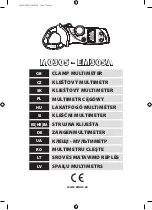
The waveforms on today’s AC power lines are anything but clean. Electronic equipment such as office computers, with their switching
power supplies, produce harmonics that distort power-line waveforms. These distortions make measuring AC voltage inaccurate
when you use an averaging DMM.
USE TRUE RMS WHEN MEASURING
AC WAVEFORMS
®
Average voltage measurements work fine when the signal you’re measuring is a pure sine wave, but errors mount as the waveform
distorts. By using true RMS measurements, however, you can measure the equivalent heating effect that a voltage produces,
including the heating effects of harmonics.
Table 1
shows the difference between measurements taken on averaging DMMs & those
taken on true RMS DMMs. In each case, the measured signal’s peak-to-peak value is 2V. Therefore, the peak value is 1V.
For a 1-V peak sine wave, the average & RMS values are both 0.707V. But when the input signal is no longer a sine wave, differences
between the RMS values & the average readig values occur. Those errors are most prominent when you are measuring square waves
& pulse waveforms, which are rich in harmonics.
Table 1. Average versus true RMS comparison of typical waveforms.
Waveform
Actual
Pk-Pk
True RMS
Reading
Average
Reading
Reading
Error
Sine Wave
Triangle Wave
Pulse (25% duty Cycle)
Pulse (6.25% duty Cycle)
Square Wave
Pulse (12.5% duty Cycle)
2.000
0.707
0.707
0%
2.000
0.577
0.555
-3.8%
2.000
1.000
1.111
+11.1%
2.000
0.433
0.416
-3.8%
2.000
0.331
0.243
-26.5%
2.000
0.242
0.130
-46.2%
One limitation to making true RMS measurements is crest factor, and you should consider crest factor when making AC measurements.
Crest factor is the ratio of a waveform’s peak (”crest”) voltage to its RMS voltage.
Table 2
shows the crest factors for ideal waveforms.
Table 2. Crest factors of typical waveforms.
Waveform
Crest Factor
DC
Sine Wave
Pulse (12.5% duty Cycle)
1.000
1.000
1.414
1.732
Square Wave
Triangle Wave
Pulse (25% duty Cycle)
Pulse (6.25% duty Cycle)
1.732
2.646
3.873
A DMM’s specifications should tell you the maximum crest factor that the meter can handle while maintaining its measurement
accuracy. True RMS meters can handle higher crest factors when a waveform’s RMS voltage is in the middle of the meter’s range
setting. Typically, a DMM may tolerate a crest factor of 3 near the top of its scale but it might handle a crest factor of 5 that’s in the
middle of the range. Therefore, if you’re measuring waveforms with high crest factors (greater than 3), you should adjust the DMM
so the measured voltage is closest to the center of the measurement range.
Another limitation of true RMS is speed. If you’re measuring relatively clean sine waves, then you can save time & money by using as
averaging DMM. True RMS meters cost more than averaging meters and can take longer to produce measurements, especially when
measuring millivolt-level AC signals. At those low levels, true RMS meters can take several seconds to stabilize a reading. Averaging
meters won’t leave you waiting.
D:/Chhaya/Coreldraw files/True RMS when measuring AC waveforms.cdr



































